Archive for ‘Motivation’ Category
Organize Your Desktop with Your Perfect Desk Pad: 2025 Update
This post originally appeared in November 2023 and has been updated for June 2025.
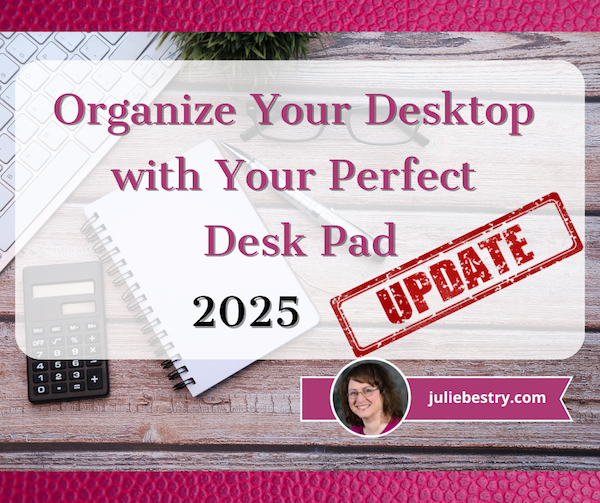
WHY USE A DESK PAD?
It’s funny how small, random things resonate with people. In early September, in Paper Doll Explores New & Nifty Office and School Supplies, I included a small section on how desk pads have come back into vogue, and shared some examples of brightly colored, inexpensive options. I’ve been surprised by how many people had follow-up questions about this rarely discussed office supply.
Desk pads are similar to but not quite the same as desk blotters, even though the two are often conflated. However, as we’re not writing with quills or fountain pens anymore, nobody is really blotting anything. Still desk pads have a variety of benefits for organizing your desk physically as well as psychologically.
Practical Reasons
Desk pads have a variety of purposes for keeping your workspace safe, organized, and comfortable. A desk pad will:
- Protect the desk from spilled beverages, sticky or crumbly foods, and scratches (either from your watch or jewelry, or from pens that dig into the desktop surface).
- Create a more comfortable workplace. This includes making the traditional writing surface smooth for when you’re actually using pen or pencil (like a caveman) or protecting your arms from the desktop’s surface. If your desk is metal or glass, the surface can be ice cold; an old wooden desk may feel scratchy or splintery. Desk pads vastly improves your comfort level because they’re generally made from softer or sleeker materials. This also provides a gentler surface to reduce friction against your wrists.
- Yield more slide-y space than a mousepad. Whether you’re using your desktop for working or gaming, a mousepad offers little space to slide your mouse around. A desk pad makes that smooth area much wider and eliminates your worry about making grander gestures.
- Reduce the sound and vibrations of a clickety mechanical keyboard.
- Designate zones for different tools. Some desk pads give you specific areas to help carve out the niche areas of purpose on your desk.
Personal Reasons
Beyond the practicalities, desk pads can create an ambiance that appeals to you on an emotional level.
- Aesthetics may help you feel more productive; at least, they put you in the right headspace to tackle spreadsheets or TPS reports.
- A desk pad makes a statement of style for the owner of the desk, to communicate personality with visitors and to delight you when you’re sitting at your workspace. Given that most of day’s post focuses on more mature styles of desk pads, in leather and and leather-like materials, I thought I’d share the kind of desk pad that the less grown-up version of me is often tempted to acquire. Because, as you may have wondered at some point, Surely Not Everyone Was Kung Fu Fighting (from Society Six).
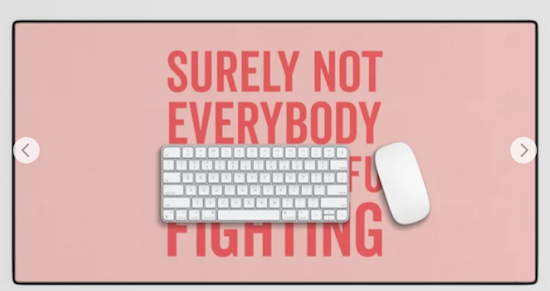
- A desk pad makes a desk look “put together.” This is less about looking attractive vs. looking finished. Paper Mommy drummed it into me that when you want to make a good impression, you should always wear a jacket, blazer, or cardigan — something that pulls an outfit together and makes it look intentional. A desk pad does the same for your desk.
DESK PAD ATTRIBUTES TO CONSIDER
Most of the inquiries I received asked about what features they should consider in a desk pad. For those used to the traditional oversized calendar style of blotter, the number of modern desk pad possibilities come as a bit of an overwhelming surprise. Let’s look at several.
Size
One hesitates to say that “size matters,” but you need to consider a variety of size-related elements:
- How large is your work area? — If your desk is enormous and you’ve got an itty bitty desk pad not much bigger than a mousepad, the desk pad is going to be engulfed, both logicically and aesthetically. If it’s only the width of your keyboard, the friction of the edges against your arm may annoy you.
Conversely, if you’re working on a tiny desk, make sure your desk pad will actually fit. Read the actual measurements, but also keep your eyes out for keywords, like “extended,” that give you an idea of the size of a product. A standard goal is to pick a desk pad that covers 2/3 of the width of your desk, but your needs may vary, given other factors.
- How much of your stuff do you want on the desk pad? — Do you want the deskpad to cover just the area closest to you, or would you prefer your computer to sit atop it? If you want your desktop and keyboard located on top of your deskpad, you’ll need more space than if you just want to put it under your laptop (or just prefer it under the area where you rest your arms).
Some desk pads are designed to be large enough to have space for your phone, mouse (so a mousepad is unnecessary), office supplies, and any papers essential to your work.
- What kind of surface do you need for your work functionality? — If you’re using a mouse instead of a track pad and a desk pad in lieu of a mouse pad, the mouse needs to be able to move smoothly but not slip on too glossy a surface. The surface should also allow you an adequate, comfortable area upon which to rest your mousing wrist.
- Do you need a desk pad to accommodate a special purpose? — Gamers often use oversized (overly wide) desk pads; engineers and computer specialists may need specialized pads for work on computers or with tools.
- Do you need options? There are varieties of desk pads with different surfaces on each side (like for gaming vs. standard computing or intricate work vs. writing). If your work and play tasks vary widely, consider looking at dual-dided pads to make sure you’re comfortable. A distracted worker is an unproductive worker.
Think about width as well as depth of your desk (and desk pad) as you look at your purchase options.
Materials
The material from which your desk pad is constructed will impact how it looks, how long it will last, and how much it will cost. Common desk pad materials include:
- Leather looks sumptuous and sophisticated, is easy to keep clean, and tends to be durable over the long term. However, it is often one of the most expensive options.
Leatherology has a wide variety of classic and modern desk pad options, but they also have some spiffy extra-long desk pads and narrower “conference and laptop” pads. They’re all in gorgeous Italian leather and are (for real leather) fairly affordable, from $95 to $170. Even their colors sound luxurious, with Bordeaux (below), Oxblood, Mocha, and Dove mixing with Tan, Black, Midnight Blue.
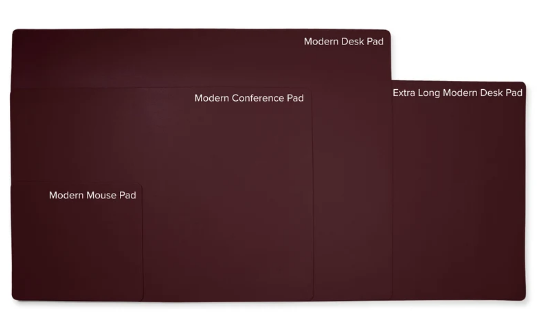
Grovemade is a similarly delicious vendor of 3.5mm-thick premium leather desk pads with cork backing in six sizes: Small – 11” x 24.75”, Small Plus – 14″ x 31.5″, Medium – 11.5” x 38”, Medium Plus – 15.75″ x 38″, Large – 26” x 38.5”, and Extra Large – 26.5″ x 49″. Small, medium & medium plus provide room for an external keyboard and mouse, while Large is designed to work under the Grovemade Monitor Stand and Laptop Stand. Prices range from $110 to a whopping $400!
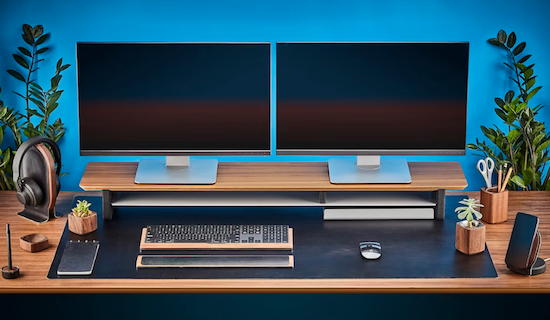
Of course, leather can get incredibly pricey. Smythson of Bond Street’s Large Desk Mat in Panama (available in Black or Sandstone) runs a hefty $1095!
- “Vegan” leather is what we used to call vinyl. It’s durable, though not so much as real leather, but it avoids the whole Bambi’s mother issue. You will sometimes see this described as “Eco” leather. If you’re not spending in the $100s, you’re almost assuredly not seeing a leather pad.
- Plastic or PVC vinyl is inexpensive, but may feel cold against your arms, can split or crack over time, and likely won’t last as long as some other varieties. That said, whether clear or opaque and colored, plastic surfaces are usually easier to clean and ideal for people who tend to stain their horizontal surfaces with coffee cup rings.
- Wool/Felt provides a cozy, hygge look, but can feel itchy or scratchy to your arms. (If you’re buying a wood desk pad as gift, make sure your recipient doesn’t have wool allergies.) Of course, a mouse will not slide on wool so you’ll still need a mouse pad, and you’re not really going to be able to handwrite on it unless you’ve got a notebook or want to fuss with cardboard backing while drafting your thank you notes.
If you’re up for spending $45-100 on cloth that you can’t even wear on date night, Graf Lantz has sophisticated Mosen Medium and Large Merino Wool Felt Desk Pad measuring 31” wide x 19 ½” high in multiple subdued colors.
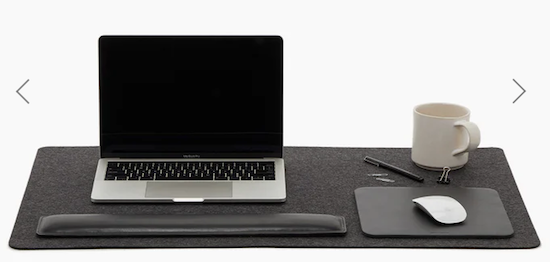
- Microfiber or Polyester — These materials tend to be relatively thin, on to top of spongy backing, making it hard to write with pencil or ball point pens, and can be hard to keep clean over the long run. These range from lower-end options to more fancy-pants versions, like the Harber London Microfibre Minimalist Deskmat, available in three sizes, from about $60-$84, from the UK.
- Cork — For example, IKEA’S minimalist Susig, measuring 17 3/4″ by 25 1/2″ is made of cork, which repels dirt and water. It’s only $8.99. Bear in mind that cork can have a strong odor, as anyone who’s ever purchased a new bulletin board will know. Buyer beware.
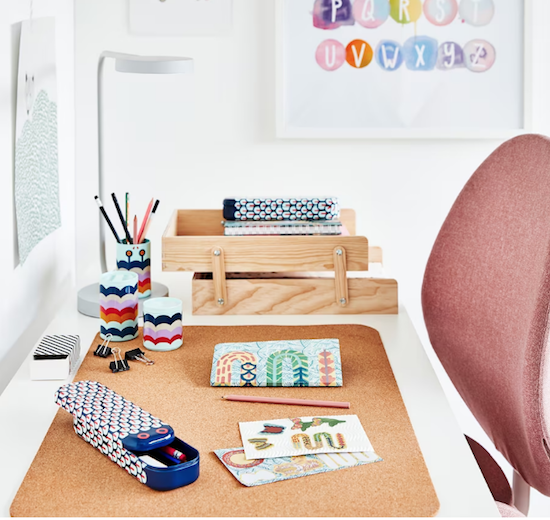
- Linoleum is an atypical options, but Grovemade makes them from linseed oil, natural pine rosin, wood flour, and calcium carbonate, with a cork backing, in ten different colors. They resist fingerprints and are antistatic and durable.
- Aluminum or Copper desk pads provide anti-static attributes. These metals have conductive properties, and will protect your computers and electronic equipment from static electricity. If you work around equipment that’s sensitive to static, like in a computer lab or server room, this is something to consider.
- Marble, glass, acrylic — These atypical desk pads are going to be cold, heavy, and slippery, but easy to clean.
I’d recommend against these icy materials unless you are far more into aesthetics than computing, but the Pottery Barn White Marble Desk Blotter may put you in “fancy society matron” mode. It comes in 24″ wide by 18″ high for $79 or 36″ wide by 18″ high (pictured below) for $99 and can be personalized.
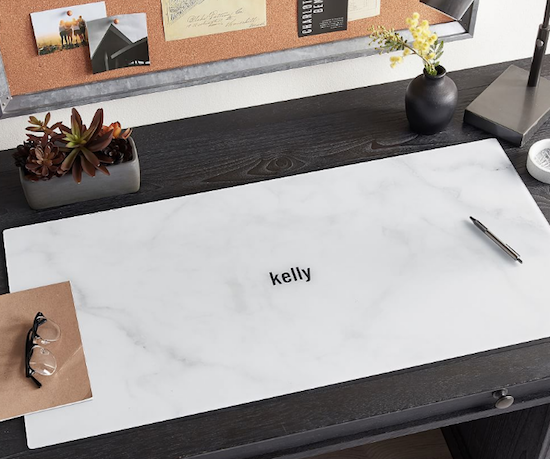
This stunning Abstract Stained Glass Desk Pad from Cozy Street Designs at Etsy might make you feel as though you are writing on behalf of royalty from the distant past to readers in the future. It comes in 7″ x 9″, 12″ x 18″, 12″ x 22″, and 15.5″ x 31″ (from $18.99 to $42.50).
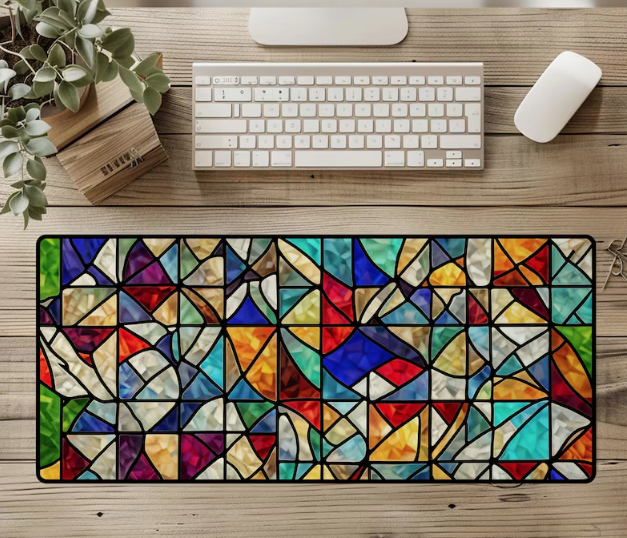
As you examine your options, ask yourself, will this material deflect spills? Morning Starbucks? Afternoon Starbucks? Late night pizza grease?
Leather and “vegan” leather are sumptuous, but will they withstand ink stains and the pressure of a ball point pen?
Do you need gutters (indentations) for pens or cord organizers or side panels on the edges to give you a sense of boundaries (and let you tuck in note cards)?
Whatever material you choose will reflect your personal style. Select something that uplifts and inspires you (or at least doesn’t frustrate you) when you approach your desk.
That said, consider that how you organize your desk reflects on your office mates or your employers. There’s some wiggle room, but if your desk pad quote Jean-Jacques Rousseau’s Eat the Rich! but you work at a high-end accounting firm, you may encounter some conflict.
Grip/Traction
You know the trick about putting a wet paper towel under your cutting board to keep it sliding around, right? You need a solution that will approximate that for your desktop.
A super-slick desk surface such as one made of metal or glass will improve your mousing capabilities but may make it hard for you to keep things from rolling away. A good desk pad has backing that provides traction for keeping your keyboard from jiggling, your pens from rolling, and your podcast microphones from sliding away.
Think about how the backing material will affect the grippiness of the pad on the desk’s surface. Look for a desk pad with backing that’s sufficiently rubbery to keep the desk pad from sliding around, but not something so inexpensive that it will get sticky or goopy near a heater or in direct sunlight as the years go by.
You also want a smooth top surface for writing, but not so smooth that your keyboard will slide around.
Organization
Psychologically, a desk pad has a calming, centering effect, much like a tablecloth or table runner in a home, dissuading you from piling junk or excess materials in your space.
A desk pad also helps you create zones, both on the pad and around the perimeter. You might find yourself keeping resources on the back third of the desk, beyond the far edge of the depth of the pad, or papers to the left of the pad and your phone and gadgets to the right.
Let your desk pad support your organizational structure, and you might find that it supports your physical as well as cognitive sense of order.
Design Aesthetic
Design also has both a functional and psychological impact.
Functionally, the design and manufacture of your desk pad can affect your comfort while you work. Those with some extra padding may be more comfortable under your arms while you’re typing. Of course, you don’t want a pad so thick that it adds bulk or adversely impacts your ergonomics. And, as mentioned, size will matter if you’re trying to create a sleek, uniform look on your desk.
Aesthetically, the combination of materials, colors, and styles determine whether your desk pad looks:
- Professional — Let’s define this to mean anything from serene to stuffy, but generally appropriate for an attorney’s office or anywhere you’re expected to dress conservatively for work.
- Sleek, modern, minimalist — If the bulk of your workspace is glass, metal, or full of spare IKEA-styled wooden furniture, you’ll want a desk pad that sets a similar tone.
- Activist-oriented — Does everything in your office convey a written message? Is your tone political (in the wider use of the term)? You may want a bold look.
- Too Cool for School — If you’re working with younger people (by which I mean adults younger than you, as parents may bristle at middle school guidance counselors decorating with edgy messages), you may want a more youthful, expressive style to maintain integrity.
- Personal — Whether you want Barbie pink or a custom-designed desk pad from NovelKeys, in the end, you need to ask: does the desk pad fit your tastes? If not, you’ll never feel entirely at ease at your desk or in your workspace.
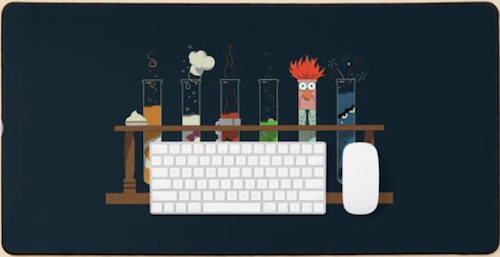
For example, this Muppet Science Chemistry Deskpad from Deep Space Designs at RedBubble measures 31.5″ x 15.7″. For less than $25, it makes a strong statement that the user cares about science — or at least Beaker.
In the end, however, it’s a desk pad, not a wedding dress. Pick a color, pattern, and material that reflects your style insofar as you’re allowed to express your true style at work.
And if you find the perfect desk pad but expect it will be received poorly at work, use it in your desk area at home — and start looking for a job that won’t stifle your soul.
Portability
If you set up a desk once and never remove anything, this won’t be a concern. However, if you hot-desk at your office, or if you’re a student who relocates to different work areas and likes your desk pad to come with you, portability may be an issue.
Some desk pads easily roll up like small yoga mats and you can keep them rolled with a rubber band or yoga mat band. Conversely, some fancy-pants desk pads, the kind made to emulate old-fashioned leather pads, are not only stiff and un-rollable, but are often weighted heavily on the left and right edges and not ideally portable.
Special Features
A desk pad is not always just a desk pad, especially in the 21st-century. Some, like the KeySmart Charging Taskpad have built-in charging capabilities. Measuring 35.43″ x 16.54″, in comes only in black. What it lacks in panache, in makes up for in features.
You can just set your phone, Airpods, or other doohickies on the mat and they’ll charge quickly, even when in their cases. It’s also water- and stain-resistant, and anti-scratch, with a no-slip-backing and PU Leather surface. There’s a “micro-textured mouse pad built in, with cushioning for wrists and forearms. It’s $120 from KeySmart and currently on sale at Amazon for $69.
Gaming keyboards are built with colorful, lighted margins to help set the ambiance. For example, see the Razer Goliathus Chroma line, which runs about $55 at Walmart and Amazon for the extended version. (You may want to turn down your volume if you’re over 30 years of age.)
And in one of the most unusual findings for this updated post, there’s The CozyDesk, a heated deskpad for those of you who grip your coffee cup for warmth, whether it’s deep in winter or your office A/C is just too brisk for your tastes.
At 31.5″ x 9.4″, the smooth leather CozyDesk has 50 different heat settings but a heat-resistant base. Your desktop and your accessories (like your mouse and keyboard) remain safe, while your fingers stay toasty warm. It has built-in safety features, including an auto-shutoff and a low-power consumption setting.

Whether you’re an office worker, student, gamer, someone suffering from poor circulation or Reynaud’s Syndrome, or just someone whose office space (or hands) are colder than you’d like, this CozyDesk promises customized warmth for your desktop workspace from 50° to a whopping 140° Fahrenheit (10°-60° Celsius).
Normally, the CozyDesk sells for $80 but is currently half off at $39 for a mid-year sale.
While there are a variety of similar heated desk pads listed on Amazon, ranging from $25 to $200, the lower-priced items are often marked as “frequently returned items.” Let the shivering buyer beware.
Price
Do you want to make a long-term commitment to one desk pad or “date” around with different options depending on your mood of the week? The more committed, the higher a price point you can embrace.
I’ve seen desk pads ranging from $10 to $200, so you should be able to augment your work space at a cost that works for you.
A FEW MORE DESK PAD EXAMPLES
Smead Desk Pads
Just as I was considering writing this blog post, I got an email from one of my favorite companies to recommend about the brand new Smead Desk Pads. The waterproof surface, described as being crafted from “premium vegan leather,” has a sturdy design to protect against keyboard scratches, water marks, and spills.
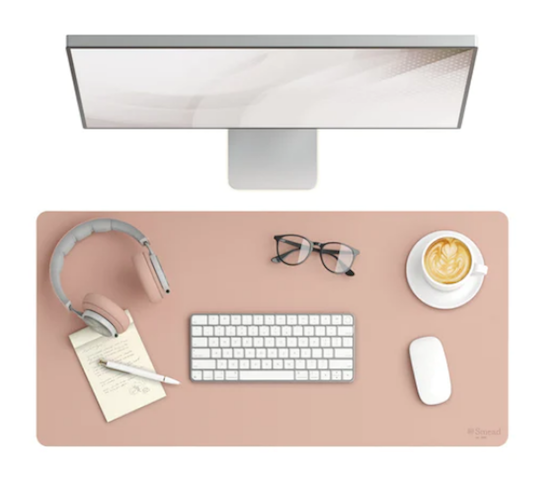
Smead notes that the faux-suede, non-slip backing will ensure stability, so it won’t wiggle while you work or write. They stated that it comes rolled for easy shipping but will lay flat without curling once it’s on your desk.
The Smead Desk Pads come in three sizes:
- Small (23.6″ x 13.7″) for $10.49
- Medium (31.5″ x 15.7″) for $12.99
- Large (36″ x 17″) for $14.99
and five colors: Blue, Dusty Rose, Saddle, Sandstone, and Charcoal.

If you’re seeking a serene, serious, vibe, like for the office of a therapist or ADHD coach, this might be ideal.
OrbitKey Desk Mat
The OrbitKey Desk Mat comes in Black or Stone, in two sizes: Medium (27.01″ wide x 14.69″ high) and Large (35.28″ wide x 16.65″ high). It’s made of premium vegan leather and 100% recycled PET felt and comes with a two-year warranty.

The OrbitKey Desk Mat has some intriguing features, including:
- a quick-access indented toolbar across the top
- a magnetic cable organizer
- a document hideaway feature, suitable for keeping your cheat sheet formulas and codes, or sensitive papers you need at your fingertips
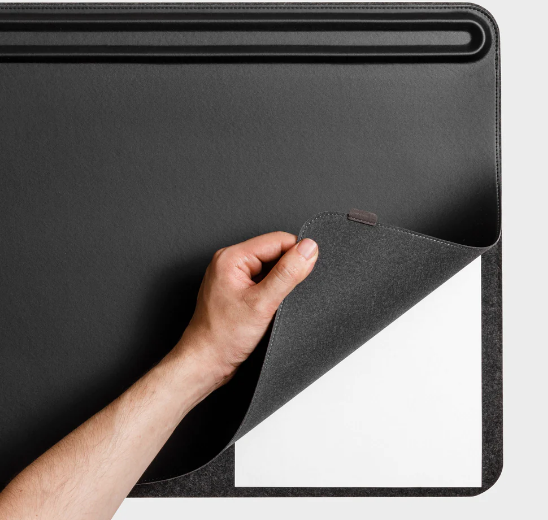
It’s also somewhat pricey (at just under $80 for Medium or $100 for Large) from OrbitKey and Amazon.
Adir Professional Reversible Self-Healing Cutting Mat
Adir’s dual-sided green and black desk pad is made of “self-healing” vinyl and comes in four sizes: 12′ x 18″ ($15), 18″ x 24″ ($25), 18″ x36″ ($45), and 36″ x 48″ ( $76) from Amazon. If you’ve got someone on your shopping list whose desk is equal parts computer desk and work bench, this option will “self-heal” if an art or mat knife or rotary cutter slices through it, keeping the surface smooth. It’s marked with 0.5 inch, as well as measurements in centimeters and millimeters, 45- and 60-degree angle guides, and diagonal cutting lines.
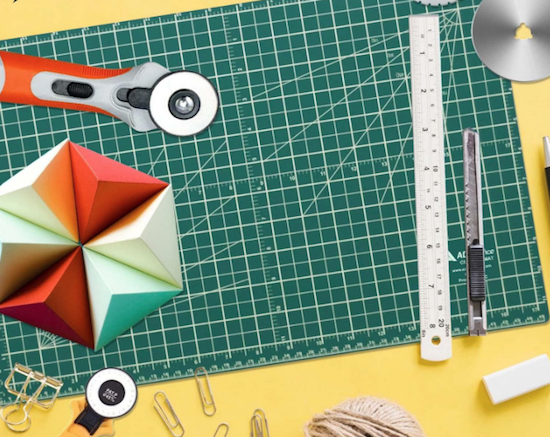
Excel Tips Deskpad (and Morning Brew)
This is actually two recommendations in one. Do you subscribe to the Morning Brew newsletter? It’s a stellar daily newsletter for catching up on all the (mostly non-stressful) national, international, business, and entertainment news delivered in a delightfully Dad-joke tone to make starting your day easier.

If you spend too much time on Microsoft Excel, you might want to look at the Morning Brew Excel Tips desk pad. It measures 27.20″x11.75″ and provides more than 60 Excel functions, 100+ Excel shortcuts, and top dialog box definitions, all for $35.

Paper Doll HQ hasn’t had the opportunity to use or rank every desk pad, so you may wish to peruse recent coverage of the best of desk pads.
The 7 Best Desk Mats, Tested By Our Editors (The Spruce)
8 Best Desk Mat Options For 2025 (Rosstopia)
9 Best Desk Mats of 2024 for a More Organized Workspace (Good Housekeeping)
The 10 Best Desk Pads to Elevate Your Workspace (The Robb Report)
The 13 Best Desk Pads to Make You More Productive and Organized at Work (Esquire)
The 15 Best Desk Pads & Mats for Your Office (Werd)
The 17 Best Desk Pads For Your Home Office (GearMoose)
21 Stylish Deskpads and Blotters for Writers (Accessory to Success)
Do you use a desk mat? What are the most important features for you to work comfortably? Do you care more about looks or texture? Do your tastes run toward luxe or funky?
How to Use Cathedral Thinking and Intentional Words to Organize Your Year

We’re not quite a week into the year. And yet, if you had resolutions, you may have already broken them. Vowed to eat healthy, but that boozy New Year’s Day brunch blew that plan out of the water? Planned to exercise daily, but those two days back at work wore you out, so you slept in instead of going to the gym this weekend?
You aren’t alone. In fact, the second Friday in January is known as Quitter’s Day because so many people have already tossed their resolutions by that day. Research by Baylor College of Medicine found that 88% of people give up their New Year’s Resolutions by the end of January; a large percentage of the remainder part ways with their resolutions before the end of April.
WHY DON’T NEW YEAR’S RESOLUTIONS WORK (FOR MOST PEOPLE)?
It’s not that resolutions can’t work, but that people generally go about them in the wrong way.
Unrealistic Expectations
It’s cute when three-year-olds tell you they’re going to be princesses, basketball stars, or wizards. But if you’re a grownup and you “resolve” that you’re going to change who you are in some massive way, your ambitious goals may get in the way of reality.
If you set an aspirational goal that’s so ambitious that you can’t possible achieve it, you’re guaranteeing that you’ll be discouraged each time you hit a setback or your progress is glacial.
Think about what I wrote in Paper Doll Explains Aspirational vs. Inspirational Clutter. Just as when you fill your space with tangible aspirational clutter, filling your head with an aspiration to achieve something lofty without the any undergirding infrastructure guarantees disillusionment and falling short.
Black-and-White Thinking
It’s common to approach goal-setting with an all-or-nothing mentality.
“Either I will publish a Pulitzer Prize-winning novel this year (even though I haven’t written anything since college)!” or “I’m going to keep this house perfectly organized every day from now on (even though I haven’t seen my keys in three weeks)!” leads people to give up when they hit the first bump in the road, so they stop writing or putting things away.
Too often, people craft their resolutions as, “I’m going to completely change how I behave” and that means that the minute they revert to their innate habits, they declare a loss. (A hot fudge sundae doesn’t mean your diet is dead and buried; tomorrow, have a salad.)
We don’t need a new year, or a new month, or even a new day to continue on with our goals. As I talked about in Organizing A Fresh Start: Catalysts for Success, we can always find new opportunities to re-set.
Shame-based Motivation
- Are you a carrot or stick person? Are you motivated to win something for the glory or by fear of not achieving?
- Are you more likely to go after a goal because it’s something you truly desire, or because you’ve been guilted into it?
- Do you want to achieve something because it’s your dream, or because you’ve been conditioned through social pressure (or from your mother-in-law or your work frenemy) to do something?
If you only set a goal because someone makes you feel bad about who you are now (whether in terms of your shape, your status, or your accolades), that extrinsic motivation probably isn’t going to have staying power to get you out of bed to run on a rainy morning or to get your butt on the piano bench to practice scales.
If you’re focused on something negative and are shamed (or shaming yourself) into changing who you are, that self-criticism is going to prevent you from making any sustainable change.
And whenever we don’t meet our resolutions, that above-mentioned black-and-white thinking can lead to low self-esteem, feelings of inadequacy, and poor mental health.
Lack of Strategic Planning
If you rang out the old year by resolving to “lose weight in 2025” or even to “lose 25 pounds in 2025,” you were resolving to magically achieve something. You can’t really “do” a resolution.
This is why the concept of SMART goals is so popular, because they promise that if you sit down and define your goals by making them specific, measurable, attainable, relevant, and time sensitive, and strategize how you’ll take action, when, and how often, and are clear on your purpose, you’ll stand a better chance. I’ve written about that often, and back in 2014 in Achieve Your Goals: Modern Truths Behind the Urban Legend, I spelled out my alternative steps to really making your goals come alive.
Merely stating your resolution without spelling out the strategies and actionable tactics is a recipe for a pretty weak soup of achievement.
For more on the problematic nature of New Year’s resolutions, read:
- The Psychology Behind Why New Year’s Resolutions Fail (VeryWellMind.com)
- New Year’s resolutions often don’t last. Here’s why they fail and how to keep them, according to an expert. (CBS)
- Why New Year’s Resolutions Don’t Work (And What You Can Do Instead!) (Forbes)
Instead, Make Real Change Through Intentions and Habits
Set positive intentions — When you do create goals, focus on whatever you want to achieve because the goal uplifts you, not because you’re trying to avoid something. (Will you be delighted, or will you only be avoiding a negative result? Unless you’re motivated by the stick, find the carrot…or the cookie.)
Have a plan, not a dream — Identify any obstacles you’ve faced in the past anticipate what may arise in the future so you can develop strategies to overcome them.
Set small, achievable objectives — You’re not going to put away everything the minute you are done with it, but you can set a timer for ten minutes before your lunch break to file away everything that’s piled up on your desk during the morning. Keep breaking down large aspects of change into ever-smaller, more manageable tasks.
In fact, if you really want to change your behaviors, I suggest reading (or re-reading) James Clear’s Atomic Habits: An Easy & Proven Way to Build Good Habits & Break Bad Ones.

Clear’s book is one of the most approachable guides to making small behavioral changes so that you can replicated them and build on them to achieve what you want.
Treat yourself with kindness — Don’t beat yourself up over backsliding; use it as an opportunity to investigate what’s tripping you up and look for creative solutions. The goal is to catch yourself winning.
Acknowledge that setbacks happen to everyone; focus on progress, not perfection. (Perfection is boring! Figuring out why you always throw your coat on a chair instead of hanging it up or always procrastinate about refilling prescriptions gives you opportunities to win!)
Seek — and accept — support! — There’s a reason people say it takes a village and that no man is an island. Humans are social animals; we’re not meant to do it all ourselves. Whether you seek the support of family or friends, delegate lesser tasks to staffers so you can focus on improving your unique skills, or work with a counselor, therapist, or professional organizer who can provide accountability and training, don’t feel like you have to go it alone.
GO LONG; MAKE A CHANGE
I’m just not a fan of resolutions. I am far more enamored of changing habits. If resolutions work for you and help you make a fresh start, go for it. But if you struggle with resolutions, it’s OK. There are better ways to introduce change in your life.
Longtime Paper Doll readers know that I’m a big fan of using words to create a positive mindset. Once I have a vision for what I want my life (or my year) to look like, I can build a theme and see if each habit or action dovetails or departs from that theme. And we’re going to look at that in a moment. But I’ve recently been introduced two additional concepts for guiding your thoughts and actions.
Cathedral Thinking
Greta Thunberg has been quoted as saying, “Avoiding climate breakdown will require cathedral thinking. We must lay the foundation while we may not know exactly how to build the ceiling.”
Oooh, cathedral thinking! I’m picturing time-lapse video of a cathedral being built from the foundation upward as the people and the city around the area change and grow over decades and centuries.
I was unfamiliar with the term “cathedral thinking” before I heard Thunberg’s quote, and did some research. Officially, cathedral thinking is a mindset focused on long-term planning and thinking about the future rather than the present. Originating in medieval Europe, the concept developed from the fact that builders of grand cathedral began projects they knew would not reach fruition in their lifetimes; they were thinking generationally.

Duomo di Orvieto (Orvieto Cathedral) Umbria, Italy @2018 Julie Bestry
Cathedral thinking is a way to view the problems we face as challenges requiring effort — sometimes collective effort by that village — and an investment of time, and perhaps money, over the long haul. When you’re talking about building literal cathedrals, that long-term planning, investment in the future prioritization of sustainability can create a tangible monument to the work you’ve put in.
But ever since I heard Thunberg’s quote, I’ve been thinking about how cathedral thinking applies to building our future selves. Maybe our initial goals are short-term: to get our homes or offices organized, or to learn how to say no to obligations that don’t fulfill us, to go to the gym, or start eating healthy.
But none of these goals exist in a vacuum. We don’t want to lose weight because the number on the scale is somehow meaningful. We’re not decluttering (merely) so that our homes look more orderly. We’re not culling the energy vampire tasks from our schedules so we’ll have a more balanced work-life schedule. Those are the interim benchmarks; those are the foundations and scaffolding and various levels of the cathedral of our individual selves.
But our true cathedrals are who and what these habits will help us become. Better eating, exercise, self-care, stress-reduction, and organized spaces mean that we will be happier, healthier, and alive and vital for longer so that we can be with the people we love, doing the things we care about.
Anyone doing a reality check knows we don’t write books to become rich; almost no published authors are making that kind of bank; nor are artists. Instead, it’s about legacy.
James Clear suggests that we can change our habits by aligning them with our identity. “I am the kind of person who eats five servings of vegetables a day” or “I am the kind of person who hangs up her clothes” may not be true, yet, but it’s tying acts to the self-image to which one aspires.
As long as that identity isn’t so aspirational as to seem out of reach, it can override the tendency we all have to blow off our goals when we just aren’t feeling it; when we just don’t wanna.
Your aspirational goals are part of your legacy, and your legacy is going to take a lifetime to build. You are a cathedral. Start by laying the foundation, and keep the future generations (that is, iterations) of your identity moving forward.
Make a Change
I’m sure you’ve heard the saying that “insanity is doing the same thing over and over again and expecting different results.”
We all struggle. Change is scary. Fear of failure, fear of success, and annoyance (and avoidance of annoyance) keep us stuck, year after year.
Recently, I was thinking about how, ever since the start of the pandemic, I’ve felt stuck. I work hard to stay safe, in terms of my health. I still wear a mask in indoor public settings and avoid crowds. But in the last six weeks, I’ve still had health issues; first, as I reported last month, I had a rough bout of vertigo; then mid-December, I had a cold (and it was, though lingering, just a cold). I petulantly resented that I’ve taken all of these precautions, have missed out on a lot of the joys of life in these years since 2020, and still got sick.
We all take precautions to protect ourselves professionally or personally, to avoid pain (the stick) but that often means we never get the carrot or the cookie. Eventually, as I wrote about in Paper Doll Says: Don’t Get Stuck in a Rut — Take Big Leaps, we have to get out of our comfort zones.
This was in my head when I had a conversation last week with the always-fabulous Deb Lee, productivity consultant, connector-of-humans, and amazing friend. Deb was talking about marketing and entrepreneurship expert Amy Porterfield, and how she often advises people to Do Something Different. You can listen to Amy’s podcast, #497: Do Something Different: A Method For Getting Unstuck, for a sense of how this philosophy, of doing something in a different way, can shake you out of your rut, blow out the cobwebs, and bring new ideas and new opportunities.
And it wasn’t just Deb quoting Amy. Within a day, my colleague and the best darned Evernote Expert you could want to know (and I’m saying that as someone who has been an Evernote Certified Expert for the past decade), Stacey Harmon of Harmon Enterprises, echoed the same idea. In her newsletter, she talked about how she chooses a word/concept of the year, and for this year, Stacey wrote,
“For 2025, I’ve chosen “Do things differently. Get different results.”
(In her newsletter, she talks about how each year, she creates a custom Evernote Home cover image containing her word or phrase of the year, overlying a photo that’s attractive to her and is in alignment with her goal. Read more about how Stacey tracks her word/phrase of the year in Evernote.)
Although hers isn’t my phrase for 2025, I’m borrowing the inspiration to remind myself to spread my wings a bit more and embrace a larger life.
USE YOUR WORDS TO ORGANIZE THE LIFE YOU WANT
Most years, I blog about the advantage of selecting a word or phrase of the year to create your mindset. While resolutions state where you want to end up and goals allow you to spell out the habits that can get you there, words or mottos for the year are different.

Scrabble Tile Photo by Brett Jordan on Unsplash
Whether you pick a word or phrase or song doesn’t matter. Rather, all formats of these words allow to set your intentions for where you want to focus your energy for the coming year in a way that uplifts and expands instead of setting restrictions and boundaries.
Last year, in Toss Old Socks, Pack Away 2023, and Adjust Your Attitude for 2024, I talked about my approach to each new year.
In particular, I went deep and wide into the concept of the personal review, a method for reflecting on the year that’s ended to get a sense of what is really meaningful to you (in categories like health, finances, professional development, business, relationships, personal growth, and community) for guiding your approach to the new year.
I recommended the amazing Year Compass, for doing your annual review and for developing your hopes, dreams, goals, and plans for the coming year.
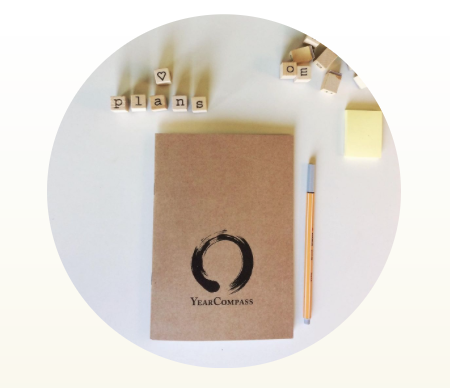
And I’d picked the word UPGRADE as my guiding word of 2024, but explained that it was battling it out with PRONOIA. I wrote:
Don’t worry if you’ve never heard of it. Honestly, the first time I heard the word, I assumed it was made up. It’s opposite of paranoia; a person experiencing pronoia believes that the world around them conspires to do them good. Obviously, taken to extremes, it might seem like psychological or spiritual irrationality.
But Buddist principles haven’t been working for me, I’m still trying to get a handle on the Stoics I talked about in Toxic Productivity Part 2: How to Change Your Mindset. I feel the pull of a bigger change in my life, and I think “pronoia” dovetails with the idea of a life upgrade.
Thus, I keep coming back to the Carly Pearl song in which I first heard the word “pronoia.”
This year, I’ve decided to upgrade the word “pronoia” to be my personal life motto. The concept that the world conspires in your favor is just too inspiring to apply to only one year.
Once you do your personal review, you’ll know what you want to accomplish this year, and more importantly, why. Maintain the motivation and energy of your “why” with a word or phrase that reflects the overall concept you want your year to engender. It’s not about losing weight, or maybe even health, but a word that reflects beyond the literal to the the larger idea of how you want to feel. Maybe buoyant or lighthearted or delighted?
Consider:
- a word of the year
- multiple words (like a trio of words) of the year
- a quote or motto or mantra of the year
- a song of the year (or a song title, or a lyric)
Whatever you select is your personal theme for the coming year. Whatever you want to remember about your goals and your attitude is what this word or phrase or mantra will reflect.
But don’t just leave your word sitting there on a notepad. Your goal is the best product or service — it’s the business of you. Use your (organized) space to keep your attention on your intention for the year, the building of your personal cathedral.
Advertise your theme word(s) anywhere or everywhere it’ll catch your attention. Don’t let it fade into the woodwork!
Promote your theme to yourself wherever you need a little push to live in accordance with the values you’re setting for yourself. Display it:
- on a sticky note on the fridge or your bathroom mirror
- on a bookmark you’ll see each time you open or close whatever book you’re reading
- on a both sides of the door leading to and from your garage, so you’ll be reminded of it when coming and going
- on one of those fun little felt word board with changeable letters placed so you see it from your desk chair or wherever you spend the most time
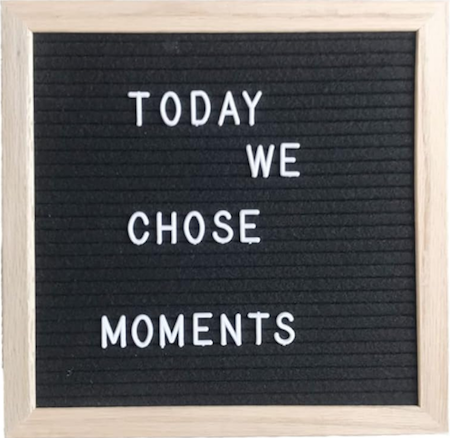
- on the lid or door of the washing machine, to remind you that those “adulting” tasks deserve appreciation
- on the door to your closet so you’ll be reminded to dress and act in accordance with your theme
- as the title of a vision board, along with images reflecting the meaning of your motivating words, phrases, and songs.
- on the lock screen of your phone
- as the desktop graphic of your computer
- on whatever software allows you to customize your home screen (like Stacey’s advice for Evernote Home)
Don’t just engage your visual sense. Add an auditory component:
- Change your wakeup alarm on your phone to your theme song.
- Record yourself speaking your word or mantra (or have a loved one do it) and use the sound file as an alarm to remind you periodically at a point in the day when your inspiration is likely to flag.
- Recite your word or phrase every night before you go to sleep and upon waking. Make it a mantra.
Whatever you pick should soothe and motivate, providing you with clearer sense of the vision you want your actions to reflect. Picture it on a banner as you cross the finish line, or carved into the marble over the doorway of your personal cathedral.
Find Your Inspiration
You don’t have to rush to find your word or phrase. A year is 365 days and we’re only six days in. And if you find that the word your pick is ill-fitting, like a jacket that’s too tight in the shoulders, you can change it.
To get you started, peruse:
Choose a One-Word Theme: We Review Our 2024 Themes and Reveal Our 2025 Themes (Happier Podcast with Gretchen Rubin)
One Word Themes for 2025 (Gretchen Rubin)
How To Choose A Word Of The Year (Elizabeth Rider)
New Year Intention (Jonda Beattie)
246 Word of the Year Ideas for a Better 2025 (GoodGoodGood.co)
2025 Word of the Year Ideas (Morgan Harper Nichols has 60 great, often unexpected words)
2025 Word of the Year (and 100 ideas for yours) (Elizabeth McKnight)
Paper Doll’s Words of Intention
I’ll be honest — I’m not ready for 2025. I usually use the last two weeks of the year to do my annual review and find the right word or phrase for the coming year. But, as mentioned, I had the creeping crud from the week before Christmas until close to the new year, and haven’t yet found my word. I’m leaning toward ENGAGE.
I liked having a word and a song last year, and keep hearing Florence and the Machine’s Dog Days Are Over running through my head, but suspect it’s one of those songs where I’m not sure that the lyrics mean what I think they mean. I’ve noticed that Natasha Beddingfield’s 2004 hit, Unwritten, is playing everywhere lately, and feel like it’s speaking to cautious, perfectionist me:
I break tradition
Sometimes my tries are outside the lines
We’ve been conditioned to not make mistakes
But I can’t live that way
Songwriters: Danielle A. Brisebois / Natasha Anne Bedingfield / Wayne Steven Jr Rodrigues
Unwritten lyrics ©2004 Sony/ATV Music Publishing LLC
Whatever I choose, I’m considering the advice of Deb and Stacey, and remembering the words of essayist and novelist Susan Sontag, in her Reborn: Journals and Notebooks, 1947-1963, where she emphasized courageously taking leaps and embracing change:
“I must change my life so that I can live it, not wait for it.”
Do you have a word, phrase, motto, or song of the year to support your 2025 mindset?
24 Smart Ways to Get More Organized and Productive in 2024

Happy New Year! Happy GO Month!
January is Get Organized & Be Productive (GO) Month, an annual initiative sponsored by the National Association of Productivity & Organizing Professionals (NAPO). We professional organizers and productivity experts celebrate how NAPO members work to improve the lives of our clients and audiences by helping create environments that support productivity, health, and well-being. What better way to start the year than creating systems and skills, spaces and attitudes — all to foster a better way of living?!

To start GO Month, today’s I’m echoing Gretchen Rubin’s 24 for ’24 theme that I mentioned recently, and offering you 24 ways to move yourself toward a more organized and productive life in 2024. There are 23 weekdays in January this year, so if you’re feeling aspirational and want to conquer all of these, you can even take the weekends off as the last item is a thinking task rather than a doing task.
I broke these organizing and productivity achievements down by category, but there’s no particular order in which you need to approach them, and certainly you don’t need to accomplish every one on the list, in January or even all year. Jump in and get started — some only take a few minutes.
PUT LAST YEAR AWAY
1) Make many happy returns!
Did you know that shoppers will return $173 billion in merchandise by the end of January? Chances are good that you (or someone for whom you oversee such things) got gifts that need to be returned.
Don’t put it off. The longer you wait, the more clutter will build up in your space, and the more likely you will be to suffer clutter-blindness until the return period has expired. Most stores have extended return policies during the holidays, but they can range upward from 30, depending on whether you have a gift receipt.
The Krazy Coupon Lady blog reviews the 2024 return deadlines for major retailers. She notes that you’ll get your refunds faster by returning items to the brick & mortar stores rather than shipping them back. You’ll also save money, because some online retailers charge a restocking fee.
2) Purge your holiday cards.
While tangible greeting are getting fewer and farther between, you probably still got a stack. Reread them one last time, and then LET THEM GO.
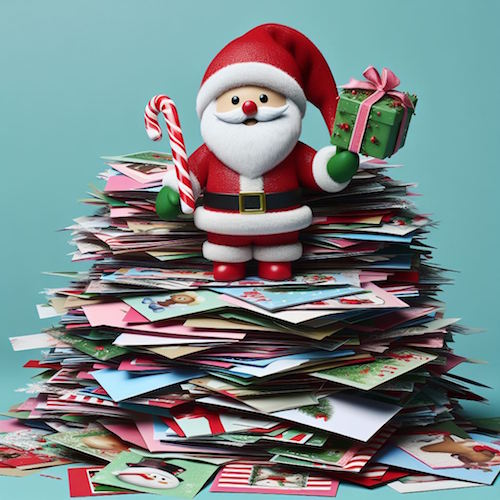
Did Hallmark or American Greetings do the heavy lifting, and the senders just signed their names? Toss them into the recycling bin. Paper Doll‘s grants you permission to only save cards with messages that are personal or resonant.
If they don’t make you cry, laugh, or go, “Ohhhhh,” don’t let them turn into the clutter you and your professional organizer will have to toss out years from now when you’re trying to downsize to a smaller home! It’s a holiday message, not a historical document; you don’t transcribe your holiday phone conversations and keep them forever, right?
The same goes for photos of other people’s families. You don’t have to be the curator of the museum of other people’s family history; let them do that.
3) Update your contacts.
Before you toss those cards, check the return addresses on the envelopes and update the information in your own contacts app, spreadsheet, or address book.
Next, delete the entries for people you’ll never contact again — that ex (who belongs in the past), that boss who used to call you about work stuff on weekends (ditto), people who are no longer in your life, and those who are no longer on this mortal coil.
If you don’t recognize the name of someone in your contacts, Google them or check LinkedIn (is it your mom’s doctor? your mechanic?) and if you still don’t know who it is, you’re obviously not going to be calling or texting them. Worst case scenario, if they text you, you can type back, “New phone, who dis?”
BOX UP YOUR INBOXES
4) Delete (most of) your old voicemails.
How often do you return a call only to hear, “The voicemail box is full and is not accepting messages. Please try again later.” When someone calls you and requests you call them back but their voicemail is full, it’s frustrating because it makes more labor for you.
Do you assume that it’s a cell phone and text them? (I believe texting strangers without permission is a breach of etiquette.) Plan to call back later? Assume that they’ll see the missed call and get back to you, starting another round of phone tag? ARGH!
Dial in to your voicemail and start deleting. Save phone numbers for anyone you’ll need to contact and log anything you may need to follow up on. But unless you’re saving a voicemail for legal purposes or because you can see yourself sitting in an airport, listening to a loved one’s message over and over (cue sappy rom-com music), delete old voicemails.
If you’ve got a landline, clear that voicemail. If you’ve still got an answering machine, how’s the weather in 1997? Yeah, delete old messages.
Smith.ai has a great blog post on how to download important voicemails (from a wide variety of phone platforms) to an audio file. Stop cluttering your voicemail inbox!
5) Clear Your Email Inboxes
Start by sorting your inbox by sender and deleting anything that’s advertising or old newsletters. If you haven’t acted on it by now, free yourself from inbox clutter! Delete! Then conquer email threads, like about picking meeting times (especially if those meetings were in the past).
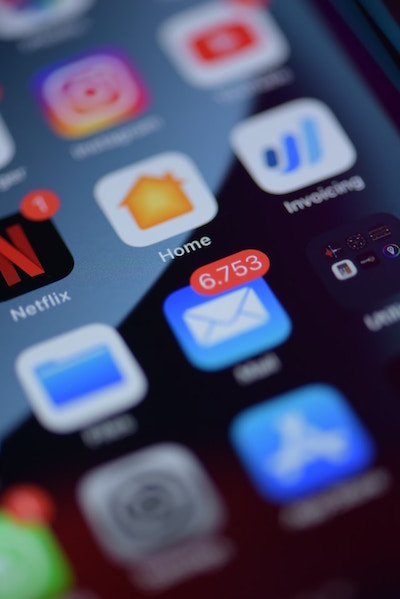
Take a few minutes at the end of each day to delete a chunk of old emails. To try a bolder approach, check out a classic Paper Doll post from 2009, A Different Kind of Bankruptcy, on how to declare email bankruptcy.
6) Purge all of your other tangible and digital inboxes.
Evernote has a default inbox; if you don’t designate into which folder a saved note should go, your note goes somewhere like Paper Doll‘s Default Folder. Lots of your note-taking and other project apps have default storage that serves as holding pens. Read through what you’ve collected — sort by date and focus on the recent items first — and either file in the right folders or hit delete!
Walk around your house or office and find all the places you tend to plop paper down. Get it in one pile. (Set aside anything you’ll absolutely need in the next few days to safeguard it.) Take 10 minutes a day to purge, sort, and file away those random pieces of paper so that you always know where they are.
HIT THE PAPER TRAIL
7) Embrace being a VIP about your VIPs.
You need your Very Important Papers for all sorts of Very Important Reasons. If the last few years have proven anything, it’s that life is unpredictable, so we need to find ways to make things as predictable and dependable as possible.
Yes, putting together essential paperwork isn’t fun. It’s boring. But you want it to be boring. The more boring your vital documents are, the more it means there will be no surprises for your loved ones in troubling times (like during and after an illness, after a death, while recovering possessions after a natural disaster) or even when you’re just trying to accomplish something like getting on an airplane.
Start with these posts, then make a list of any document you already have (and where it is), and another list of what you need to create, and plan meetings with your family and a trusted advisor to set things in motion.
How to Replace and Organize 7 Essential Government Documents
How to Create, Organize, and Safeguard 5 Essential Legal and Estate Documents
The Professor and Mary Ann: 8 Other Essential Documents You Need To Create
Paper Doll’s Ultimate Guide to Getting a Document Notarized
Paper Doll’s Ultimate Guide to Legally Changing Your Name
A New VIP: A Form You Didn’t Know You Needed
8) Create your tax prep folder now so you’ll be ready for April 15th.
Do you toss non-urgent mail on top of the microwave? Might those important 1099s and 1098s and 1095-A and W-2s get lost? Don’t lose deductions, pay more taxes, or get in trouble with the IRS!
By the end of January, you’ll start getting tax documents in the mail. Pop them in a folder in your financial files or in a dedicated holder like the Smead All-in-One Income Tax Organizer.
Paper Doll’s 23 Ideas for a More Organized & Productive 2023
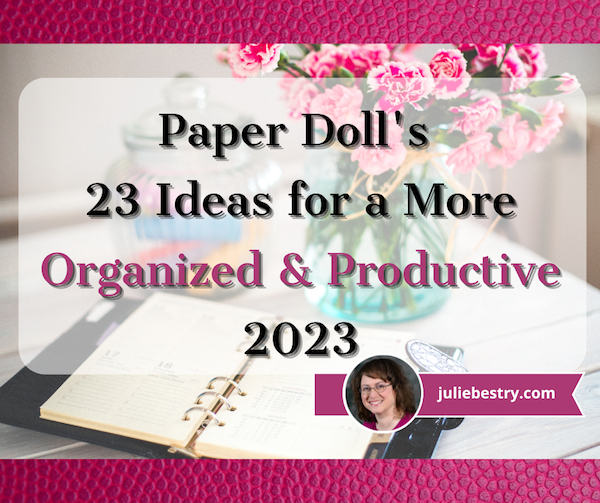
Happy New Year! And welcome to GO (Get Organized) Month 2023, where we celebrate efforts to make our spaces more organized and make ourselves more productive.

We in the National Association of Productivity and Organizing Professionals (NAPO) love this opportunity to help you make this year your best. To that end, today’s post offers up 23 ideas for achieving what you want this year in your space, schedule, and life.
CREATE A FRESH MINDSET
1) Learn last year’s lessons to build next year’s success.

You were probably super-busy last week, but I encourage you to read the final Paper Doll post of 2022. (Trust me, it was a good one!)
Organize Your Annual Review & Mindset Blueprint for 2023 is full of questions and resources for figuring yourself (and your last year) out.
I often joke to clients that while I’m not a mental health professional, I am like a marriage counselor between you and your stuff. Well, last week’s post is like a cross between a therapy session and a deep dive with your BFF. It rejects the demoralizing proposition of resolutions in favor of creating a fresh, motivating mindset for the coming year, whether with a word, quote, or motto of the year, and uses signage, a vision board, or a music playlist to keep your eyes on the prize that is your new and improved life.
2) Don’t take my word for it. Listen to James Clear.
If you’ve been paying attention to the news in the “habit” realm at all in the last few years, you know that James Clear wrote Atomic Habits: An Easy & Proven Way to Build Good Habits & Break Bad Ones, a book that takes the research of habit researchers (like Charles Duhigg in his The Power of Habit) and makes it all actionable.
How Professional Organizers (& Hair Stylists) Reverse Some Intolerable Problems
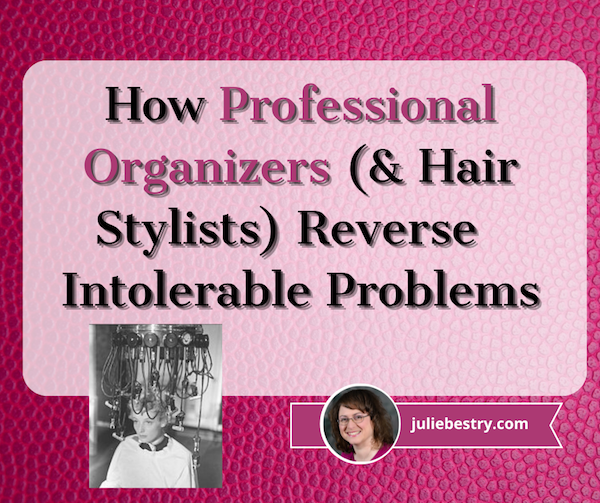
Kabarett der Komiker; Gisela Schlüter unter Friseurhaube by Willy Pragher (CC BY 3.0)
What’s annoying you today? What’s been annoying you so long that you almost don’t notice the annoyance until someone else mentions it?
Over Labor Day weekend, my air conditioner died. This was an acute problem, one that I noticed almost immediately (as the temperature was rising overnight instead of going down) and which led to much misery until the holiday weekend ended and the maintenance staff could address the problem fully.
(To be fair, they did bring a mobile A/C unit, which cooled my bedroom to a bearable temperature; unfortunately, it was so loud, I felt like I was sleeping adjacent to a jet engine. Sometimes, you trade one intolerable thing for another. That’s often what keeps you from seeking, or implementing a solution in the first place.)
That same weekend, I realized that my fridge was dying. Unlike the A/C unit, this was a less obvious thing to tolerate. The freezer was still working perfectly, and the contents of the fridge weren’t warm; they just weren’t entirely full-on chilly. Weeks earlier, the refrigerator had been making some moaning noises, but fiddling with the settings of the circa-1986 fridge seemed to stop the noise. And then I stopped noticing.
Two household problems, but one felt a lot more urgent than the other. But these weren’t the only problems.
Early in the pandemic, to ensure everyone’s safety, our complex had asked us to understand that they’d only be performing inside maintenance for emergencies. So, when we had torrential rains in the summer of 2020, the roof was repaired immediately; the ceiling, well, not so quickly.
When my hot water heater expired in the spring of 2021, I vacated my home and the nice gentlemen figured out the complexities of draining a water heater on the second floor to enable removal and installation of a new one. And later that summer, my smoke detector decided to start beeping in eight sequences of three loud bursts, every ten minutes, ALL.NIGHT.LONG. That was something I could not tolerate (and thankfully, the leasing office agreed).
However, there were other, smaller repairs where I managed DIY solutions or made do. It was easier to avoid contact during the pandemic for non-emergency issues. And then I just started tolerating some inconveniences.
WHAT YOU TOLERATE NEVER GOES AWAY
A few years ago, in Organize Away Frustration: Practice The Only Good Kind of “Intolerance,” we discussed how the first step to creating the kind of life you want is to start by identifying the unsatisfying things that you tolerate. Knowing what makes you unhappy helps you create a strategy for eliminating those “tolerations,” the obstacles to your happiness. (This is true with organizing tangible items, as well as dealing with things in your schedule, and even non-organizing things, like annoyances in our relationships and whether we live our true values.)
Knowing what makes you unhappy helps you create a strategy for eliminating those 'tolerations,' the obstacles to your happiness. Share on XAs I mentioned in that prior post, I see part of my role as a professional organizer and productivity expert as helping my clients identify the areas in which they’ve been tolerating inconveniences far too long. Recent client situations have included:
- Carla* never could find gift certificates when she was ready to use them. They were always in drawers, or in the greeting cards with which they were given. We collected all of them and then separated restaurant gift certificates from shopping gift certificates. The former might be used on any given evening when she and her spouse were already out of the house and might drop in somewhere to eat, so we created a wallet for dining out cards. For the latter, given that Carla only shopped on Saturday, we clipped them together and put them in the Saturday slot of her tickler file. (Every new gift card or certificate went to one of those two places from then on.)
- Joe always had trouble figuring out how to adjust the settings on his DVR. It didn’t help that his box of manuals included instructions for every gadget and device he’d owned since the early 1970s. We purged all of the manuals that applied to defunct gadgets, created folders in the “household” section of the Family Files with one folder for each type of technology (computers, entertainment, kitchen, etc.) But then we scanned the DVR instructions that plagued him as a PDF and put it in the Notes app on his phone so it was even easier to access (and enlarge).
- Jenny’s pantry was crowded with ingredients, including a wide variety of items marked “gluten-free.” But nobody in Jenny’s household was avoiding gluten! It turns out that an occasional weekend houseguest cooked while visiting and she needed gluten-free ingredients. We rearranged the pantry so that the occasional guest had her own labeled shelf, and everyone was happier.
- Patsy saw that when she’d click on a link, her browser would sometimes give her a “web kit error” or just a blank page. She’d been copying the link from one browser (Safari) to another (Chrome) where it would work just fine, but lately, she’d been having to do that more and more, increasing her frustration. Upgrading her operating system allowed her to upgrade her browser, and she no longer had to struggle.
* All names have been changed to protect client confidentiality.
Sometimes professional organizers are dealing with clutter, but all organizers end up dealing with obstacles to productivity. The problem is that we’re all more likely to ignore a problem that can’t be fixed immediately.
When we’re focused on the task at hand, whether that’s work or school or driving or parenting, the thing we’re doing is more likely to have a deadline or at least be time-based. We postpone removing the obstacle until such time as it becomes too large or problematic to withstand. This is what happens when people keep driving with the “Check engine” light glowing on their dash panel.

RECENT TOLERATIONS TACKLED
As I wrote about in Organize Away Frustration: Practice The Only Good Kind of “Intolerance,” many of the “intolerables” in our lives can be conquered with a little research and applying one of the following:
- A product
- A service
- A change in behavior
- A change in attitude
In that post, I shared how I was almost unrelievedly ecstatic to find a new kind of shower curtain hook that made changing out shower curtain liners much easier on my short-of-stature self. Today, I’d like to share just a few recent examples of how applying a combination of solutions have removed annoyances.
A Tale of Two TVs
Do you have any of those old, boxy CRT TVs in your home? I did. In fact, I had three, which is kind of ridiculous when you realize I’m a singleton. You see, I’d had a television in my living room and another in my bedroom. When the bedroom TV died (so long ago that I’m embarrassed to discuss the exact date), I moved the living room TV to the bedroom.
When I met a friend for lunch one day, she surprised me by having brought one of her old, boxy CRT TVs for my use! To this day, I’m flummoxed as to how she ever got it into her car, and though I recall basically rolling/sliding it up the carpeted stairs of my apartment, I’ve got no idea how I ever managed to get it from my car to my own front door. (Perhaps this is like how they claim women forget the pain of childbirth?)
Eventually, I got a modern flat-screen TV for my living room. But I also embraced the advice not to have screens in the bedroom (to avoid that sleep-stealing blue light) and got rid of cable in that room. Thus, I had a broken TV, a gifted (no longer used) TV, and an unused TV. All on the second floor of my home.
Did I mention these are big, heavy, boxy TVs?
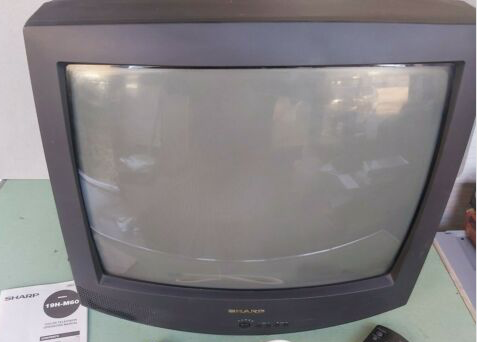
Remember how I said I had my hot water heater replaced last year? Well, one of those TVs took up most of the empty space at the top of the staircase, and so even though our apartment complex had been pretty insistent that we were never to ask the maintenance men to carry or remove anything unrelated to their work, the guys decided that it would be to everyone’s benefit to get that one TV out. Yay! But that still left two.
To be fair, I wasn’t always just tolerating the annoyance of having two unused, dust-catching, space-hogging CRT TVs in my home. I had called the various junk haulers in town, but they wanted a frustratingly large fee for something that I could have done myself, had I only been stronger, had slightly longer arms to get fully around the TVs, and had been a bit taller (so I could have seen the stairs over the top of the TVs and not feared tumbling down).
Yes, even we professional organizers fall prey to those self-imposed obstacles. Had I thrown a little money at the problem, it would have been solved back then.
I also called many non-profits, but nobody wanted donated CRTs.
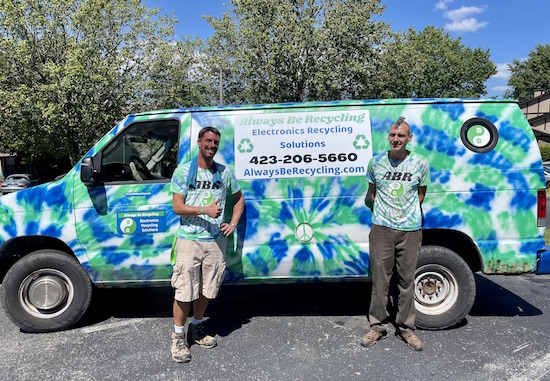
Fast forward to late August, when I contacted Chattanooga’s Always Be Recycling. The owners, a couple who’d moved from Pennsylvania, opened their business here just at the start of the pandemic. I’d networked online with Leann Cinaglia to see how their services might dovetail with my clients’ needs. The last time we’d spoken, they weren’t able to handle CRTs because of the difficulty in recycling them, but on a day where the frustration had just gotten too high, I called to see if they might have any suggestions for other solutions. And that’s where the magic happened!
It turns out that annoyingly boxy 20″ CRT TVs have become popular with the retro gaming crowd! After one short phone call, Always Be Recycling’s co-owner Jamison Cinaglia and his associate Bret (pictured above) arrived on time the next day and quickly removed both TVs and oodles of old landline phones, cables, and cords as well — at no charge. (Had I lived significantly farther from their venue, there would have been a fee, but significantly less than the various junk haulers had quoted me.)
Throughout the entire interaction, they were professional, careful, friendly, and polite. This bodes well for knowing they’ll treat my clients, especially the elderly and/or delicate ones, with respect and compassion.
So, this is a reminder that sometimes, the key is to continue to ask for input on solutions until the right one appears.
No Longer Hot Under the Collar
Not all intolerances are about excess or clutter. A major frustration in my life is heat. (And no, that’s not specific to the air conditioning and refrigerator woes.) I’m just always too hot. I hydrate. I wear temperature-appropriate clothing. But no matter what, even my head perspires and my hair frizzes and I end up looking like Art Garfunkel. (No offense, Art.)
And yes, I realize that a Buffalonian living in the Deep South might have found a more obvious solution to that problem over three-plus decades.
I’ve tried those evaporative cooling neck scarves and “chilly towels.”




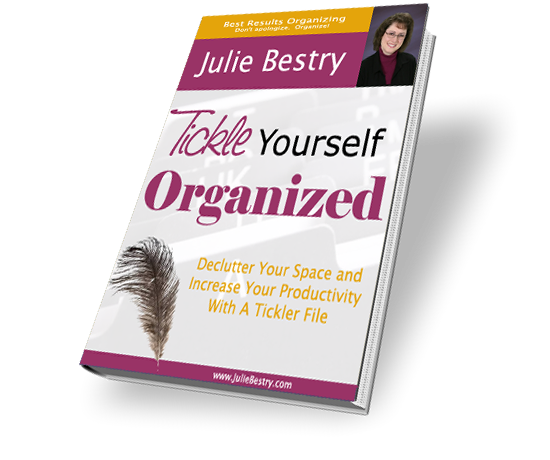




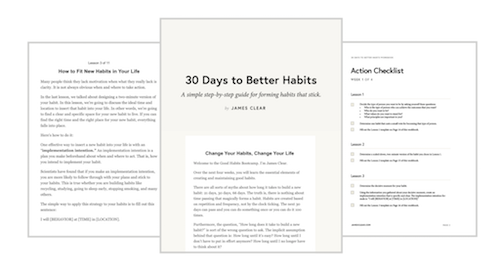
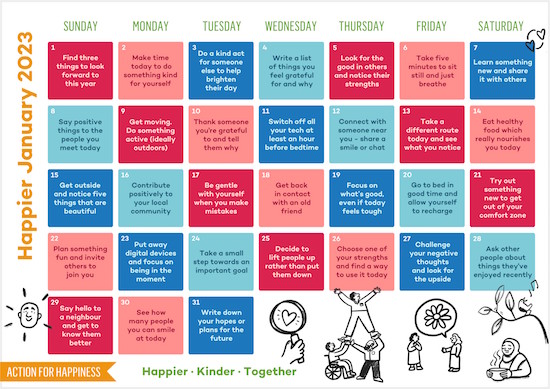
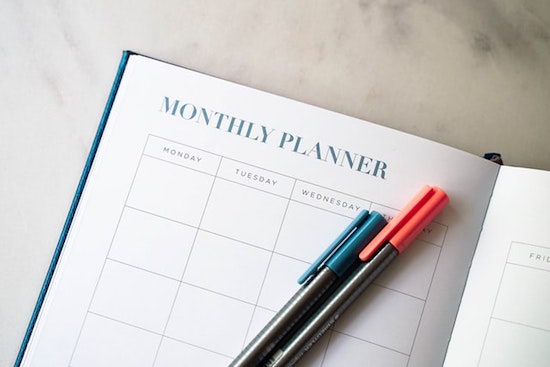




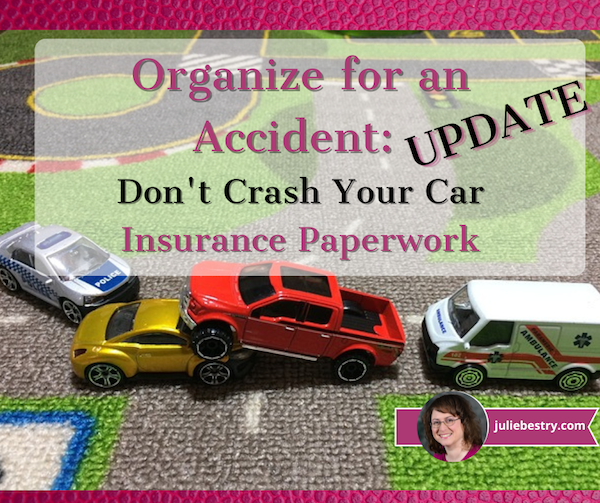

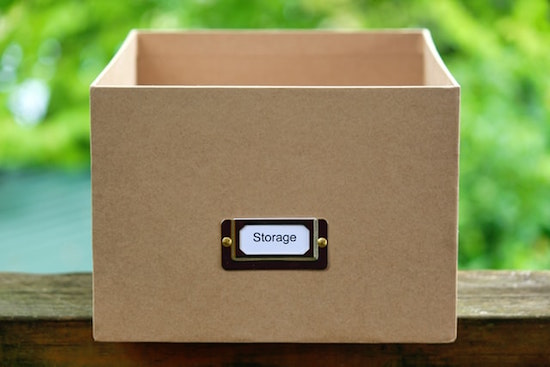


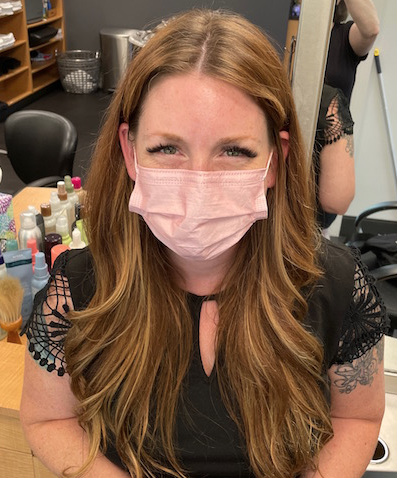




Follow Me